What Are the Different Drawing Views of the Body Called
| 5.one INTRODUCTION | |||
| Drawings are the main vehicle of communication in the construction industry, and in learning to read and interpret blueprints, it is necessary to develop the ability to visualize the object to be built. Orthographic projection principles are basic to all fields in the construction manufacture. In order to be capable of interpreting a cartoon, one must be able to relate the dissimilar views. It is often non possible to read a blueprint by looking at a single view; two or three views may exist needed to correctly read and visualize the form. Figure 5.1 shows three example of objects requiring only ii views to read. Effigy 5.2 shows a cartoon using three views. Whether sketching or cartoon, the objective is the same. The goal is to communicate the necessary detail to the targeted audition, whether it is the architect, manufacturer, or customer. Without the ability to communicate, architects, and engineers cannot function in a team. Competency in drawing and sketching are essential advice tools for architects, engineers, and those involved in the edifice trades and manufacturing industries. In the estimation of complex objects, even three drawings are non normally adequate to convey all the necessary information. Additional special views may be required, including pictorials, auxiliary views, sections, and exploded views. A view of an object is technically known as a projection. Pictorials are an ancillary category within orthographic projection. Pictorials evidence an image of an object as viewed from a skew direction in society to reveal all three directions (axes) of space in 1 picture. Orthographic pictorial instrument drawings are often used to approximate graphical perspective projections, merely there is attendant baloney in the approximation. Considering pictorial projections innately accept this distortion, smashing liberties are often taken for economy of effort and best effect. Pictorials are discussed later in this chapter. five.ii ORTHOGRAPHIC (MULTIVIEW) DRAWINGS AND PROJECTIONS | |||
| For many years architects and engineers have utilized a organization known as orthographic projection to accurately represent three-dimensional objects graphically on paper. In contempo years the term "multiview | |||
| Copyright © 2009 by The McGraw-Hill Companies, Inc. Click hither for terms of use. | 71 | ||
| 72 | Chapter v | ||
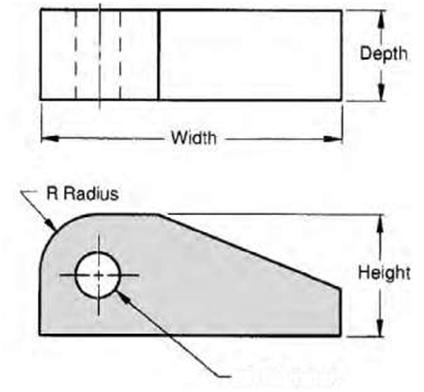 | |||
| 0 Bore Figure v.1A An case of a simple cartoon of objects that substantially requires only two views to read. | |||
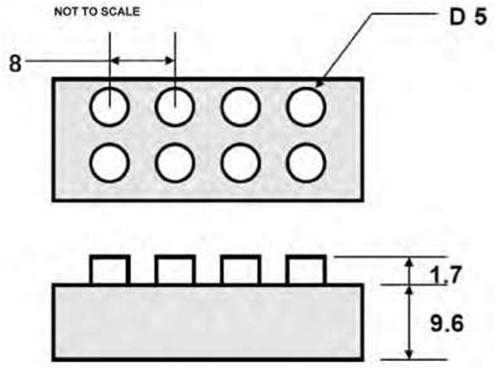 | |||
| Figure 5.1B An instance of a simple cartoon of objects that substantially requires but two views to read. | |||
| Types of Views | 73 | ||
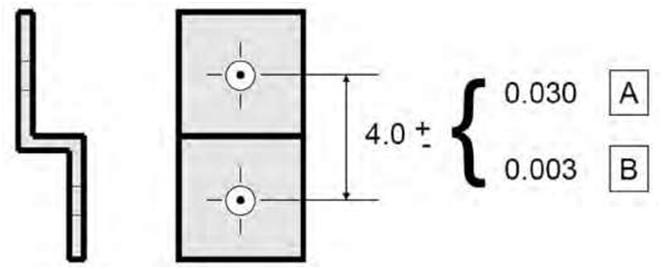 | |||
| Figure 5.1C An example of a simple drawing of objects that essentially requires only two views to read. | |||
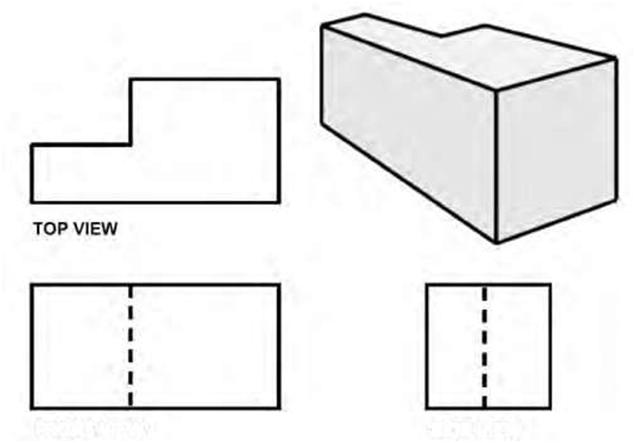 | |||
| FRONT VIEW SIDE VIEW Figure 5.2 A drawing of an object requiring three views to interpret correctly. | |||
| 74 | Chapter 5 | ||
| drawing" has come up into general use, indicating that more than one view is used to illustrate an object, but the terms are essentially synonymous. "Orthographic" comes from the Greek word for "straight writing (or drawing)." Orthographic projection shows the object every bit information technology looks from the front, right, left, tiptop, lesser, or back, and different views are typically positioned relative to each other co-ordinate to the rules of either showtime-angle or third-angle projection. Ortho views depict the exact shape of an object seen from i side at a time equally yous are looking perpendicularly to it without showing whatever depth. A single view of an object is rarely adequate to show all necessary features. Figure v.3 is an example of orthographic projection showing the six chief views used by architects and engineers in construction and industrial drawings. Common types of orthographic drawings include plans, elevations, and sections. The well-nigh obvious attribute of orthographic cartoon is its constant scale—that is, all parts of the drawing are represented without foreshortening or distortion, retaining their true size, shape, and proportion. Thus, in an orthographic drawing, a window shown to be viii anxiety wide past 4 feet loftier will always be drawn at this size, no affair how far it is from our viewpoint (Effigy 5.4). Plans are actually orthographic views of an object as seen directly from in a higher place. Floor plans are the nearly mutual form of plan; they delineate the layout of a building. A floor plan is represented past a horizontal section taken through the building or portion of a edifice just above the windowsill level. In addition to the arrangement of rooms and spaces, floor plans need to bear witness the location of various architectural elements such as stairs, doors, and windows and details such equally wall and partition thickness. Generally, the greater the calibration of a drawing, the more detail that information technology is expected to contain (Figure 5.5). Thus, a drawing at a scale of 1/iv″ = 1'0″ will typically comprise more data and prove more than detail than a cartoon at a 1/8″ = 1'0″ scale. Too, a scale of 1:two is greater than that of 1/4 inch = 1 foot, 0 inches. Other types of plans used in edifice structure may include site plans, which typically show the layout of a site; foundation plans. which show the edifice structure; and reflected ceiling plans, which are commonly used to locate calorie-free fixtures and pattern features. Two important rules that must exist adhered to in orthographic drawing are the placement and alignment of views, depending on the type of projection to be used. These rules are discussed beneath. In add-on, project lines between the views must be aligned horizontally and vertically. Orthographic (multiview) projection is a generally accepted convention for representing iii-dimensional (3D) objects using multiple dimensions (2d) of the front, top, lesser, back, and sides of the object. In practise, the minimum number of views possible is used to describe all the details of the object. Usually, a front view, top, and single side view are sufficient and are oriented on the paper co-ordinate to accepted convention. Figure v.half-dozen represents a multiview projection for a uncomplicated house. The projection conspicuously shows that information technology is a class of parallel project, and the view management is orthogonal to the projection plane. Isometric projection attempts to represent 3D objects using a single view. Instead of the observer viewing the object perpendicular to it, the object is rotated both horizontally and vertically relative to the observer. There are rules and conventions to guide the creation of both types of projections. Additionally, either of them can be supplemented with diverse types of dimensions. First-Angle Project Beginning-angle projection is the ISO standard and is used more often than not in Europe and Asia. If we imagine projecting a 3D object into a transparent plastic cube, the main object surfaces are projected onto the cube's walls then that the peak view is placed nether the front view and the right view is placed at the left of the front view, a two-dimensional representation of the object is formed by "unfolding" the box and viewing all of the interior walls every bit is shown in Figure 5.7A. | |||
| Types of Views | 75 | ||
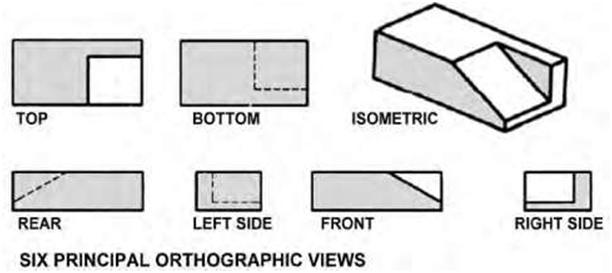 | |||
| Figure five.3 An illustration of an object showing the six principal views in orthographic project based on third-angle projection. | |||
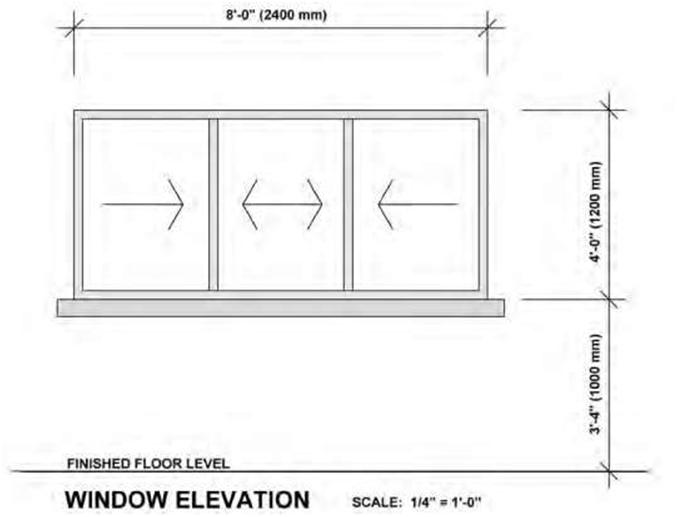 | |||
| Figure 5.4 An elevation of a window drawn in an orthographic format retaining its true size, shape, and proportion and showing no baloney or foreshortening. | |||
| 76 | Chapter 5 | ||
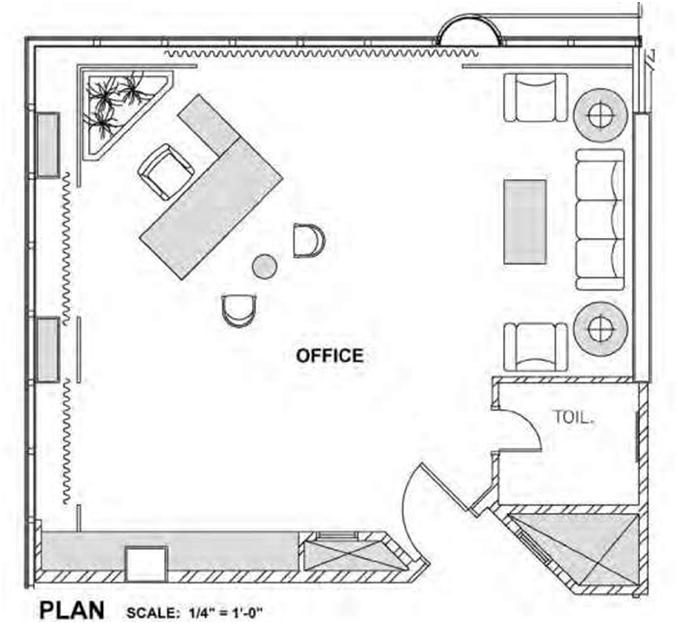 | |||
| Figure 5.5A Design drawing plan of an part space fatigued to a calibration of 1/4 inch = ane foot, 0 inches. Notice that in that location are no dimensions every bit would be establish in a typical orthographic working cartoon. | |||
| In first-angle projection, the object lies in a higher place and before the viewing planes; the planes are opaque; and each view is pushed through the object onto the airplane furthest from it. Extending to the six-sided box, each view of the object is projected in the direction of sight of the object onto the interior walls of the box; that is, each view of the object is drawn on the opposite side of the box. | |||
| Types of Views | 77 | ||
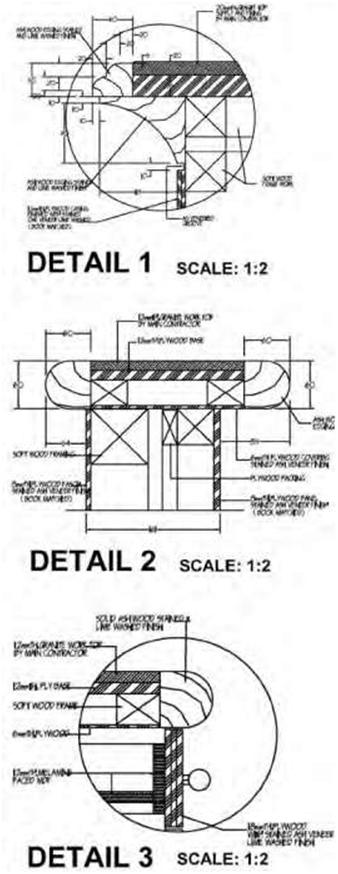 | |||
| Figure 5.5B Counter detail drawing to a scale of 1:2. This cartoon is to a greater scale and has more detail than the ¼ inches = i foot, 0 inches cartoon. | |||
| 78 | Chapter 5 | ||
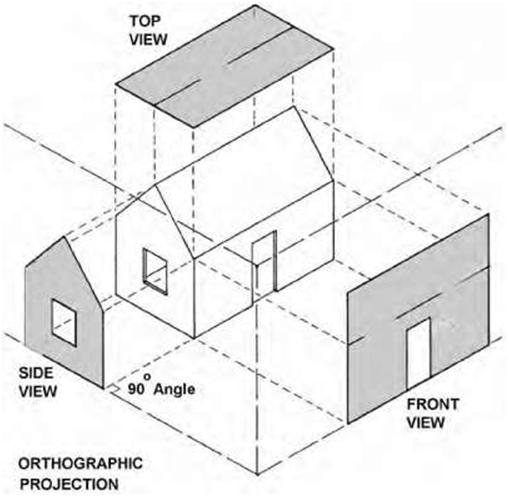 | |||
| Figure 5.vi A multiview projection for a simple house. This is the format most used by architects and engineers. | |||
| Third-Bending Projection In third-bending project the left view is placed on the left and the meridian view is placed on the acme (Effigy five.seven B and C). This type of projection is primarily used in the United States and Canada. It should be noted that not all views are necessarily used, and determination of which surface constitutes the front, back, top, and bottom varies depending on the project used. In third-angle projection, the object lies below and behind the viewing planes. The planes are transparent, and each view is pulled onto the plane closest to it. Using the six-sided viewing box, each view of the object is projected opposite to the direction of sight onto the exterior walls of the box; that is, each view of the object is drawn on the same side of the box. The box is so unfolded to view all of its exterior walls, as shown in Figure five.7C. | |||
| Types of Views | 79 | ||
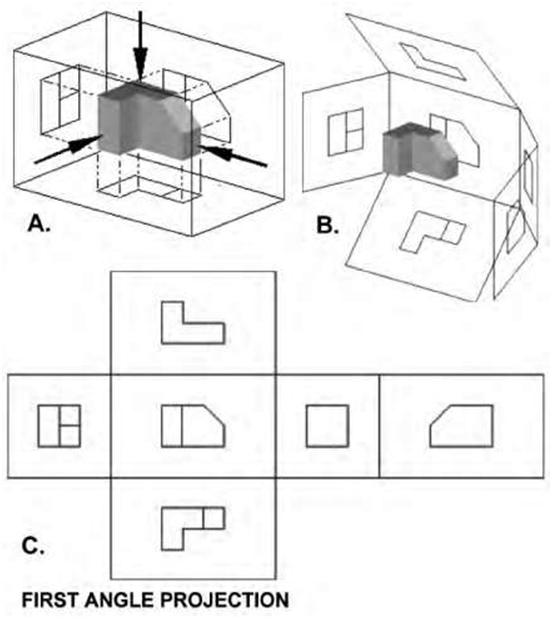 | |||
| Figure 5.7A Views of an object beingness projected co-ordinate to first-angle project which is the ISO standard and is primarily used in Europe and Asia (source: Wikimedia Commons). | |||
| Single-View Drawings One-view drawings are commonly used in the manufacturing industry to represent parts that are uniform in shape. These drawings are often supplemented with notes, symbols, and written information. They are normally used to describe the shape of cylindrical, cone-shaped, rectangular, and other symmetrical parts. Leaders are frequently used to relate a annotation to a item feature, as in Figure v.viii. Sparse, flat objects of uniform thickness are typically represented past one-view drawings. | |||
| 80 | Chapter five | ||
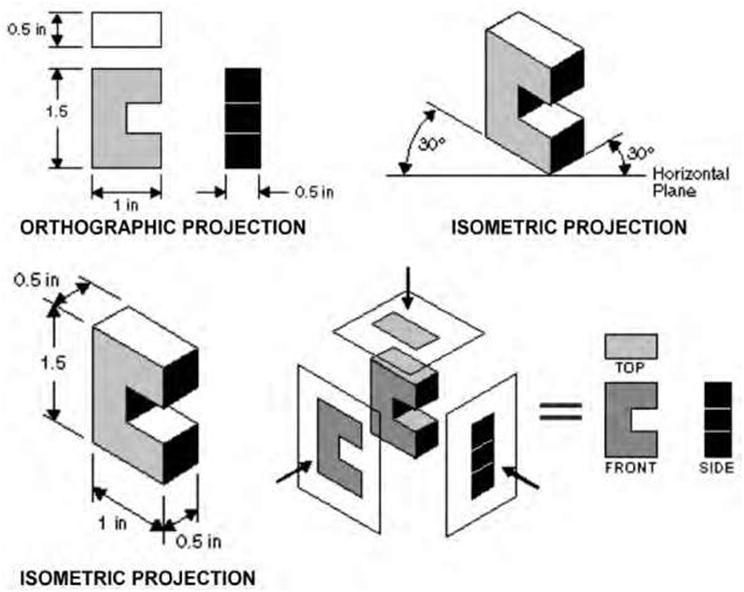 | |||
| Figure five.7B Examples of third angle projection that is primarily used in the United States and Canada. This type of projection produces ii plan views and 4 side views. In 3rd angle projection the left view is put on the left and the top view on the top. | |||
| Two-View Drawings Elementary, symmetrical flat objects and cylindrical parts, such as sleeves, shafts, rods, or studs, require merely two views to show the full details of construction. The two views usually include the front end view and either a right side or left side view or a top or lesser view. | |||
| Types of Views | 81 | ||
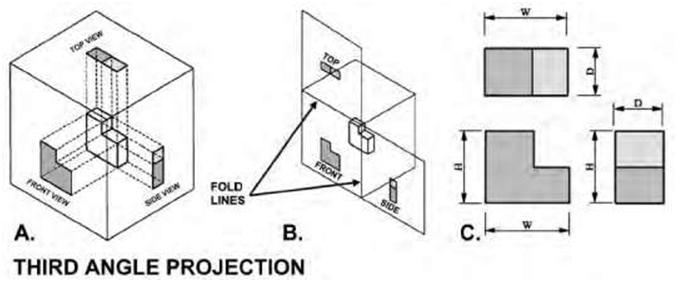 | |||
| Figure 5.7C More examples of third angle projection that is primarily used in the United States and Canada. This type of project produces ii plan views and four side views. In tertiary angle projection the left view is put on the left and the top view on the summit. | |||
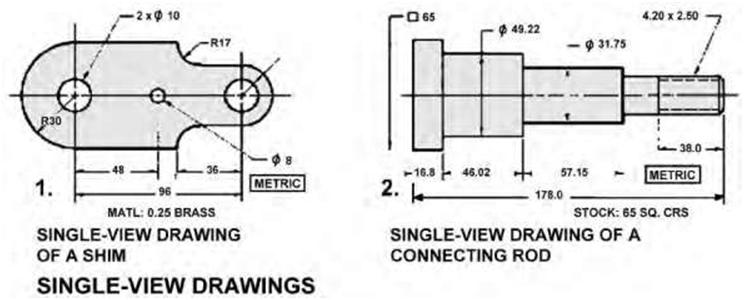 | |||
| Effigy 5.8 Two examples of single-view drawings, which are normally used in manufacture to represent parts that are uniform in shape. | |||
| 82 | Chapter 5 | ||
| Features on both sides of a centerline shown on a drawing are the same size and shape. These equal-length short, parallel lines are placed outside the drawing of the object on its centerline (Effigy 5.9). A hidden particular may be straight, curved, or cylindrical. Whatever the shape of the item and regardless of the number of views, it is represented by a hidden edge or invisible edge line. Iii-View Drawings Regularly shaped flat objects that require merely simple machining operations may often be fairly described with notes on a ane-view drawing. However, when the shape of the object changes, portions are cut away, or complex machining or fabrication processes must be shown, the single view would normally exist inadequate to draw the object accurately. The combination of front, top, and right side views represents the method almost commonly used past drafters to depict elementary objects (Effigy 5.10). For building construction, other views would typically be needed. The Front end View Earlier an object is drawn, it is examined to determine which views will best furnish the information required to construct the object. The surface shown every bit the observer looks at the object is called the front view. To draw this view, the drafter goes through an imaginary process of raising the object to centre level and turning it and so that merely one side can exist seen. If an imaginary transparent plane is placed between the heart and the face of the object and parallel to the object, the image projected on the airplane is the aforementioned as that formed in the eye of the observer. The Top View To describe a peak view, the drafter goes through a process like to that required to obtain the front end view. However, in third-bending projection, instead of looking squarely at the front of the object, the view is seen from a betoken direct above information technology. When a horizontal plane on which the top view is projected is rotated so that it is in a vertical aeroplane, the front and top views are in their proper relationship. In other words, the top view is always placed immediately above and in line with the forepart view. The Side View A side view is developed in much the same way that the other two views were obtained. That is, the drafter imagines the view of the object from the side that is to be drawn and and then proceeds to draw the object as it would appear if parallel rays were projected upon a vertical aeroplane. 3-Dimensional Graphics Depicting three dimensions on a flat piece of paper is a very important skill for designers, enabling them to communicate their ideas to other people. This is especially useful when showing your pattern to non-professionals such as managers and marketing personnel. There are several tried and tested iii-dimensional drawing systems used to produce a realistic representation of an object. Some techniques, such equally isometric project, are based on mathematical systems; others endeavor to convey a larger degree of realism by applying perspective to the cartoon. Amongst the methods covered in this tutorial are oblique, isometric, axonometric, and perspective drawing. | |||
| Types of Views | 83 | ||
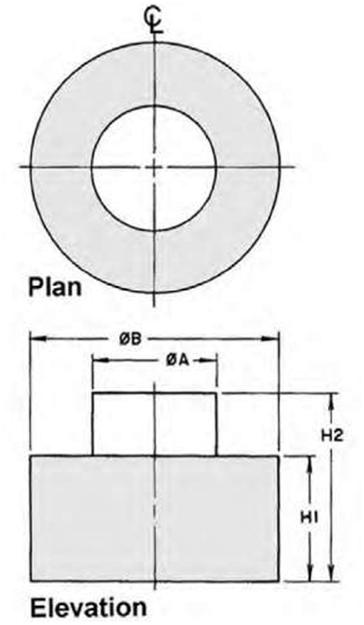 | |||
| Figure 5.9 Two-view drawings are used mainly for simple, symmetrical apartment objects and cylindrical parts. The views usually include a front end view and either a right or left side view or a acme or bottom view. | |||
| 5.3 Project SYMBOLS | |||
| The International Organization for Standardization (ISO) recommends the incorporation of projection symbols on drawings that are produced in one country for utilise in many countries (Figure 5.11). The projection symbols are intended to promote the accurate commutation of technical data through drawings. | |||
| 84 | Chapter v | ||
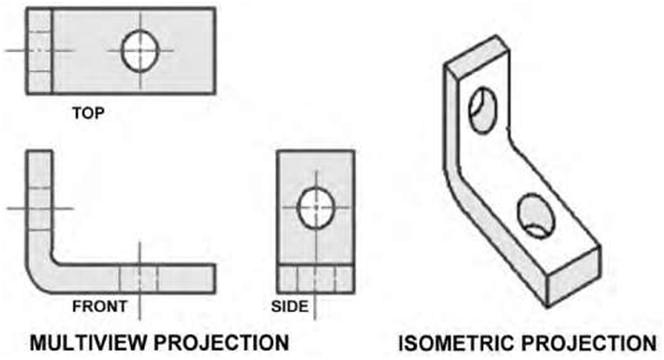 | |||
| Effigy 5.10 Iii-view drawings are typically required for more complex shapes. The combination of front end, height, and right side views reflects the method usually used by drafters to describe these objects. | |||
 | |||
| Effigy five.11 The ISO projection symbols betoken whether a starting time-angle or third-angle projection is being used in a drawing. | |||
| Types of Views | 85 | ||
| Equally mentioned before, the U.s.a. and Canada apply the tertiary-bending organisation of projection for drawings, whereas other countries employ a different system known as first-angle projection. The purpose of introducing the ISO project symbols is to signal that there is a continuously increasing international substitution of drawings for the product of interchangeable parts. Thus, the symbol indicates whether the drawing follows the third- or starting time-angle projection system. The ISO projection symbol, the notation on tolerances, and data on whether metric and/or inch dimensions are used on the drawing should appear every bit notes either inside the title block or adjacent to information technology. The designation of project type is not always included with the symbol on a cartoon. It is rarely used on architectural drawings but is usually included on technology drawings. When drawings are transferred from i convention to some other, considerable confusion is encountered in drafting rooms and engineering departments. On engineering science drawings, the project angle is denoted by an international symbol consisting of a truncated cone, respectively, for beginning-angle and third-bending and whether the cone is to the right or left of the 2 concentric circles symbol. The 3D interpretation of the symbol tin be deduced by envisioning a solid truncated cone continuing upright with its large end on the floor and the modest end upward. The top view is therefore 2 concentric circles ("doughnut"). In detail, the fact that the inner circumvolve is drawn with a solid line instead of dashed lines designates this view equally the top view, not the bottom view. Both first-angle and third-angle projections event in the same six views; the difference between them lies in their organisation around the box. five.4 OBLIQUE DRAWINGS | |||
| Oblique projection is a uncomplicated class of parallel graphical projection used mainly for producing pictorial, two-dimensional images of 3-dimensional objects. Oblique drawings are similar to isometrics except that the front view is shown in its true shape on the horizontal line—i.e., when drawing an object in oblique, the front end view is fatigued flat (Effigy 5.12). Thus, information technology projects an paradigm past intersecting parallel rays from the iii-dimensional source object with the drawing surface. In oblique projection (as in orthographic projection), parallel lines from the source object produce parallel lines in the projected image. The projectors intersect the projection aeroplane at an oblique angle to produce the projected image, as opposed to the perpendicular angle used in orthographic project. A 45-degree bending is the about commonly used to depict the receding lines from the forepart view, but other angles are acceptable. In an oblique sketch, circular lines that are parallel to the frontal plane of projection are drawn at their truthful size and shape. Hence, circular features appear as circles and not every bit ellipses. This is the main advantage of the oblique sketch. The three axes of the oblique sketch are fatigued at the horizontal, vertical, and a receding angle that can vary from 30 to lx degrees. Whereas an orthographic projection is a parallel projection in which the projectors are perpendicular to the aeroplane of projection, an oblique projection is i in which the projectors are not perpendicular to the plane of projection. With oblique projection all three dimensions of an object can be shown in a single view. Oblique drawing is a primitive class of 3D drawing and the easiest to master. It is not a true 3D arrangement but a ii-dimensional view of an object with contrived depth. Instead of drawing the sides full size, they are simply fatigued at half the depth, creating a suggested depth that adds an element of realism to the object. Even with this contrived depth, oblique drawings look very unconvincing to the heart. In Effigy 5.13 the side views are drawn at a 45-caste angle. In oblique project the side views are typically fore- | |||
| 86 | Chapter 5 | ||
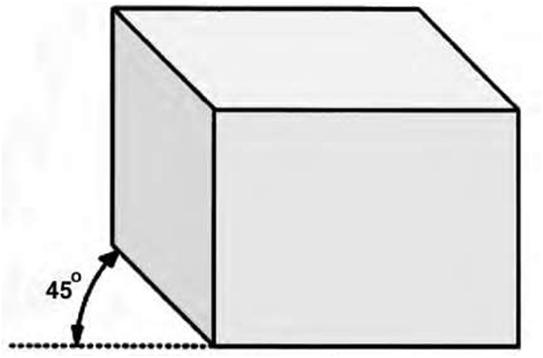 | |||
| Figure five.12 Technique for producing an oblique cartoon. The front view is shown in its true form on the horizontal line and should exist drawn flat. | |||
| shortened to provide a more realistic view of the object. To foreshorten the side views, the object'south side measurements are ordinarily halved. In this case, the sides are 50 mm (two inches) long, simply they have been fatigued at 25 mm (1 inch). Because the oblique drawing is not realistic, it is rarely used by professional architects and engineers. 5.5 AUXILIARY VIEWS | |||
| Occasionally we observe surfaces or features on drawings that are oblique to the main planes of projection and nevertheless are shown in their true shape. Other features in modern construction are too designed at various angles to the principal planes of projection. To show these features or surfaces in truthful shape for accurate description, auxiliary views are used. Auxiliary views are appropriate to obtain a true size view; like techniques to standard views unfolding most an centrality are used. Auxiliary views are usually fractional views and show just the inclined surface of an object. In Figure 5.xiv the true size and shape of the object are shown in the auxiliary views of the angular surface. An auxiliary view is similar to an orthographic view except that it is projected to a plane parallel to the auxiliary surface and non to the customary orthographic planes. It is thus drawn at an bending to all-time view an object but not i of the primary or- | |||
| Types of Views | 87 | ||
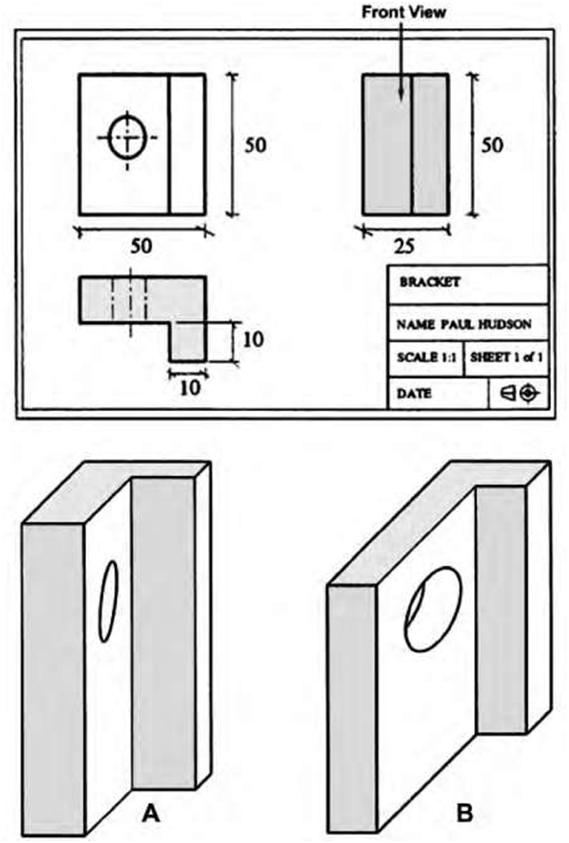 | |||
| Figure five.13A,B A. Oblique cartoon with foreshortening. B. Oblique cartoon with no foreshortening. Notice how the circle looks elongated (source: Paul Hudson). | |||
| 88 | Chapter 5 | ||
| thographic projection views. The resulting view then reflects the truthful shape of the oblique characteristic while eliminating much time-consuming projection for the drafter. Auxiliary views may be full or partial views. Rounded surfaces and circular holes, which are distorted in the regular views and appear every bit ellipses, appear in their true sizes and shapes in an auxiliary view, as can exist seen in Figure 5.14B. Auxiliary views are named co-ordinate to the position from which the inclined confront is seen. For instance, the auxiliary view may be a forepart, acme, bottom, left, or right view (Figure 5.15). In drawings of circuitous parts involving compound angles, 1 auxiliary view may be developed from another auxiliary view. The start auxiliary view is called the primary view, and the views developed from it are called secondary auxiliary views. 5.6 AXONOMETRIC PROJECTION | |||
| Axonometric projection is a technique used in orthographic pictorials. Within orthographic projection, ax-onometric projection shows an image of an object as viewed from a skew direction in order to reveal more than one side in the same motion-picture show, dissimilar other orthographic projections, which show multiple views of the same object along different axes. Because with axonometric projections the scale of distant features is the aforementioned equally for near features, such pictures will look distorted, especially if the object is mostly composed of rectangular features. The technique, even so, is well suited for illustration purposes. | |||
 | |||
| Figure 5.14A,B 2 examples of auxiliary-view projections. The illustrations show that the auxiliary views are non i of the primary views of the orthographic projection. | |||
| Types of Views | 89 | ||
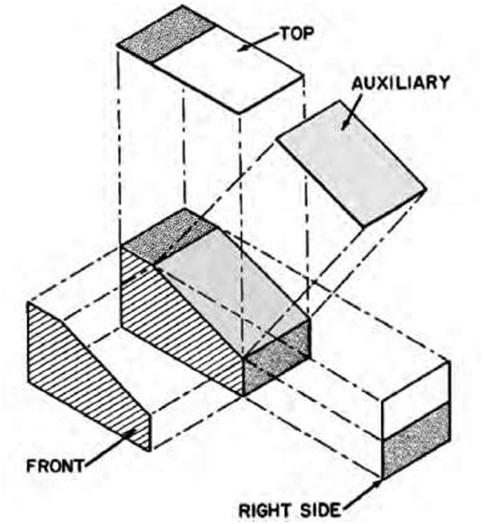 | |||
| Figure 5.fifteen Another example of an auxiliary-view projection showing how information technology relates to an orthographic projection. | |||
| The distinguishing feature betwixt projections and drawings is the unit of measurement employed. In projections a scale is constructed, which is used for measurements takeoff. The units of measurement used yet are variable depending on the projection, and standard units of measurement are not used; in drawings, however, standard units of measurement (east.g. inches, feet, centimeter, etc.) are always used. The scales synthetic for isometric, dimetric, and trimetric projections are always smaller than the standard units of measurements from which they are derived. This basically ways that axono-metric projections are e'er smaller than axonometric drawings. An axonometric drawing of an object, although slightly distorted, is yet visually equally satisfactory as an axonometric projection of it. Axonometric drawings are normally preferred to axonometric projections because no time is wasted constructing the scales needed to generate the axonometric drawings. An axonometric cartoon is one that is accurately scaled and depicts an object that has been rotated on its axes and inclined from a regular parallel position to give it a three-dimensional advent. The | |||
| ninety | Chapter 5 | ||
| chief advantage of axonometric drawing is that one can utilize an existing orthographic plan without any redrawing. The programme is simply tilted to the desired angle. It should be noted that in much of Europe, an axonometric drawing ever has its centrality at a 45-degree bending; an isometric centrality is either thirty/thirty degrees or 30/60 degrees. The virtually common axonometric drawings are isometric, dimetric, and trimetric (Figure 5.16). Typically in axonometric drawing, ane axis of space is shown as the vertical. Axonometric, or planometric, drawing, as it is sometimes called, is a method of cartoon a program view with a third dimension. Information technology is used by interior designers, architects, and landscape gardeners. A program view is drawn at a 45-caste bending, with the depth added vertically. All lengths are drawn at their true lengths, unlike oblique drawing. This gives the impression that you lot are viewing the objects from above. One advantage of axonometric drawing is that circles drawn on the top faces of objects tin can exist fatigued unremarkably. Isometric Drawing and Isometric Projection The term "isometric" is derived from the Greek for "equal measure," reflecting that the scale along each axis of the projection is the aforementioned, which is not truthful of some other forms of graphical projection. One of the advantages of isometric perspective in technology drawings is that 60-caste angles are piece of cake to construct using only a compass and straightedge. The isometric drawing is most ordinarily used in its truthful form giving "equal measure" and foreshortened views of iii sides of the object. An isometric drawing is one form of pictorial drawing. Subconscious lines are not normally inserted. Isometric cartoon is a method of visually representing three-dimensional objects in two dimensions, in which the three coordinate axes appear equally foreshortened and the angles between any two of them are 120 degrees. Isometric project, like orthographic projection. is used in technology drawings. An isometric drawing tin exist easily constructed by using a 30-60-90-degree triangle and T-square or with CAD programming. Effigy 5.17A and B shows 2 examples of isometric drawings in an architectural context. Figure 5.17C gives an example of an architectural drawing using both orthographic project (elevation) and isometric projection (details). | |||
 | |||
| Effigy five.16 Dissimilar types of axonometric projections (isometric, dimetric, and trimetric) and perspective. In much of Europe, an axonometric uses a 45-caste bending as opposed to the 30/60-degree angles used in isometric drawing. | |||
| Types of Views | 91 | ||
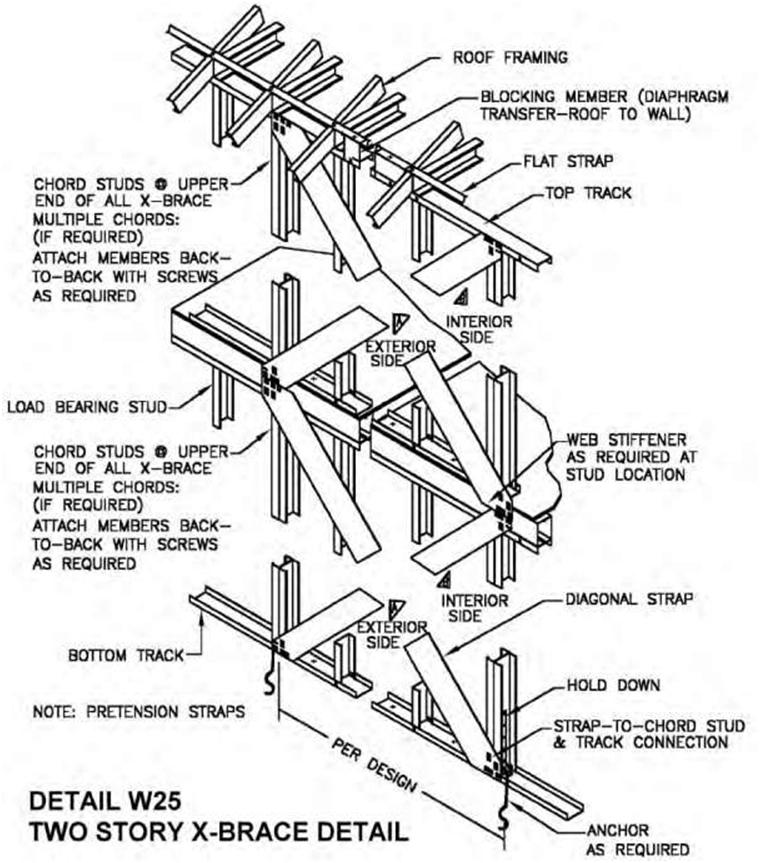 | |||
| Figure 5.17A An example of the use of isometric drawings in architecture and engineering (source: Due north American Steel Framing Brotherhood). | |||
| 92 | Chapter 5 | ||
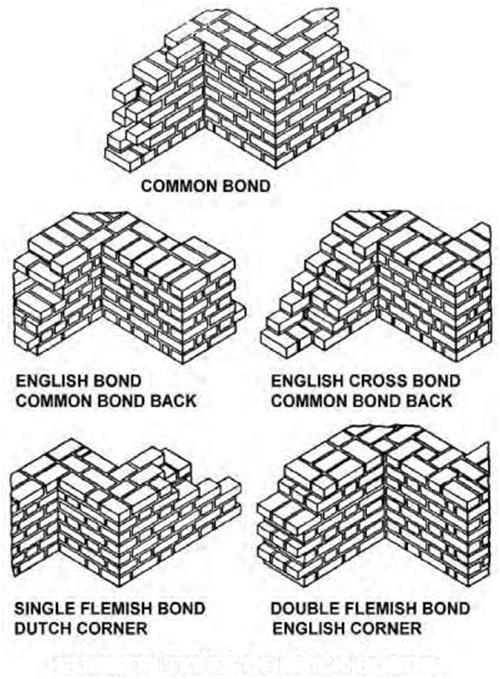 | |||
| COMMON TYPES OF BRICK BONDS Effigy 5.17B An case of the utilise of isometric drawings in architecture and engineering. | |||
| Comparison of Isometric and Orthographic Drawings Compare the simple rectangular block shown in the orthographic representation (3rd-angle projection) in Figure 5.18 and the three-dimensional isometric representation. Notice that the vertical lines of the orthographic and isometric drawings (views A and B) remain vertical. The horizontal lines of the orthographic drawing are not horizontal in the isometric drawing just are projected at 30- and 60-degree angles; the length of the lines remains the aforementioned in the isometric and in the orthographic drawings. | |||
| Types of Views | 93 | ||
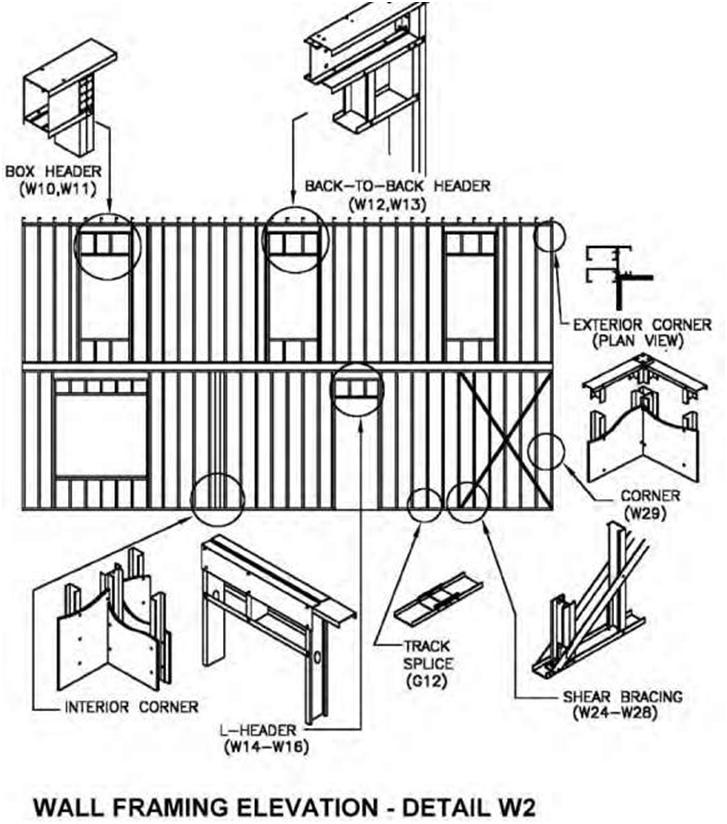 | |||
| Effigy 5.17C An instance of the apply of isometric drawings in architecture and engineering (source: North American Steel Framing Alliance). | |||
| 94 | Chapter v | ||
| Purpose of Isometric Drawing The task of an isometric drawing is primarily to prove a three-dimensional picture in i drawing. Information technology is like a picture that lacks artistic details. Many utilities workers take difficulty in conspicuously visualizing a piping or ducting installation when they are working from a flooring plan and an height drawing. The isometric cartoon facilitates understanding by combining the floor plan and the elevation. Information technology conspicuously communicates the details and clarifies the human relationship of the pipes in an installation. Although isometric drawings are not ordinarily fatigued to calibration on blueprints, some architects and engineers prefer cartoon them to calibration. Isometric drawings, like other types of drawings, follow sure rules and conventions to show iii dimensions on a apartment surface. Dimensioning Isometric Drawings An isometric drawing, or sketch, is dimensioned with extension and dimension lines in a fashion somewhat similar to that of a two-dimensional drawing. The extension lines extend from the drawing, and the dimension lines are parallel to the object line and of equal length to it. Dimensioning the isometric drawing is more difficult because it consists of a single view, with less room bachelor than on three separate views. Circles or holes volition be skewed or drawn within an isometric square. For example, a circle will appear elliptical in shape and is actually drawn by connecting a series of four arcs, drawn from the eye-lines of the isometric foursquare. The ellipses may as well be drawn with the use of templates. Curved or round | |||
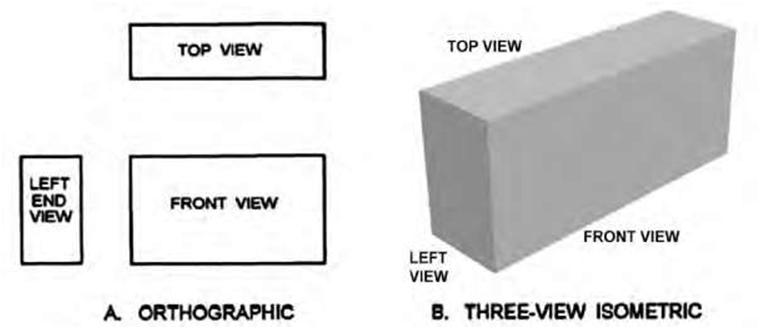 | |||
| Figure 5.eighteen A. Orthographic views of an object (3rd-angle projection). B. Three-view isometric drawings of the aforementioned object. | |||
| Types of Views | 95 | ||
| corners are drawn in the same manner by locating the cease of the radius on the direct line and and so connecting the two points to grade a triangle. The third betoken of the arc is actually the center of the triangle. Connect the three points with a freehand arc. In isometric projections the direction of viewing is such that the three axes of infinite appear equally foreshortened. The displayed angles and the scale of foreshortening are universally known. Still, in creating a final, isometric instrument drawing, a full-size scale—i.e., without the use of a foreshortening cistron—is oftentimes employed to skilful effect because the resultant distortion is difficult to perceive. Isometric drawing render a three-dimensional view of an object in which the 2 sets of horizontal lines are drawn at equal angles and all vertical lines are drawn vertically. In the resulting drawing all iii angles are every bit divided near a centre bespeak, and all 3 visible surfaces have equal emphasis. Orthographic techniques cannot be used in isometric drawings. Any bending can be used to draw an isometric view, just the well-nigh mutual is 30 degrees because it tin can be fatigued with a standard triangle and gives a adequately realistic view of an object. Today, CAD programs are the easiest manner to draw isometric projections, but isometrics are also quick to describe manually and tin be measured at any user-friendly scale. To manually draw in isometric, you lot will need a thirty/60-degree set square. There are iv elementary steps to manually draw a 5-inch box in isometric (Figure 5.19): 1. Describe the front vertical edge of the cube. ii. The sides of the box are drawn at 30 degrees to the horizontal to the required length. 3. Depict in the back verticals. iv. Fatigued in top view with all lines drawn 30 degrees to the horizontal. When you start starting time working with isometric techniques, use a simple box as a basic building cake or guide to help y'all draw more than complicated shapes. Figure 5.twenty shows how to use such a simple box to accurately draw a more than complicated Fifty shape. The first step is to lightly describe a guide box. This box is the size of the maximum dimensions. In this instance, information technology measures v inches in length, 2.five inch in width, and 5 inches in height. To reach the L shape, nosotros need to remove an area from this box. Depict a second box measuring 4 x 1 x 5 inches, the shape that needs to be removed from the get-go box to create the shape we require. For the finished shape, describe in the outline of the object using a heavier line. By using this technique complex shapes can be accurately drawn. Circles in isometric do not appear circular. They appear skewed and are actually elliptical. In that location are several methods of amalgam circles in isometric drawing. For many transmission tasks the easiest method is to use an isometric circle template, which can be bought at most practiced art shops. These templates contain a number of isometric circles of various sizes. Isometric circles can also be drawn manually using the following method: 1. Describe an isometric square and and so draw in the diagonals, a vertical, and a line at xxx degrees from the midpoint of the sides, every bit illustrated in Effigy five.21. 2. Place your compass signal on the intersection of the horizontal and the vertical lines and depict in a circle that touches the edges of the box 3. For the next section of the isometric circle place your compass indicate on the corner of the isometric square and draw in the arc as shown in the illustration. iv. Complete the circle by repeating the process for the other parts, using the advisable techniques. | |||
| 96 | Chapter five | ||
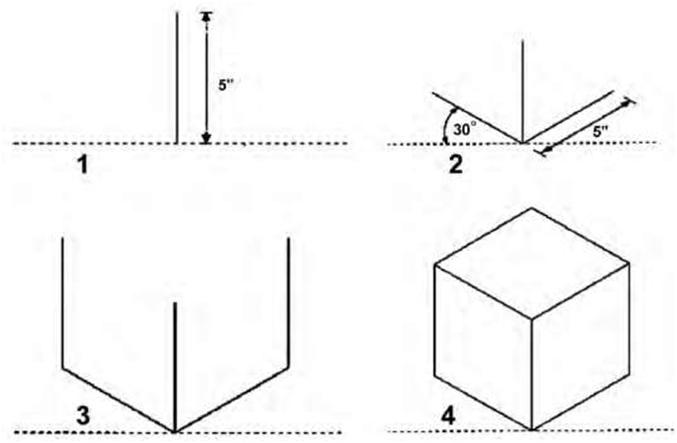 | |||
| Effigy v.nineteen The four steps in drawing a simple five-inch box in isometric. Note that all lengths are actual size in standard isometric drawings. | |||
| Dimetric Project Dimetric projection is an axonometric project of an object placed in such a way that ii of its axes make equal angles with the plane of projection and the third axis makes either a smaller or a greater angle. In dimetric projections, the directions of viewing are such that two of the iii axes of space appear equally foreshortened, with the bellboy calibration and angles of presentation determined co-ordinate to the bending of viewing; the scale of the third direction (vertical) is adamant separately. Approximations are common in dimetric drawings. Effigy 5.22 shows different arrangements for isometric, dimetric, and tri-metric drawings. | |||
| Trimetric Projection Trimetric projection is an axonometric projection of an object and then placed that no two axes make equal angles with the plane of projection and each of the three principal axes and the lines parallel to them, re- | |||
| Types of Views | 97 | ||
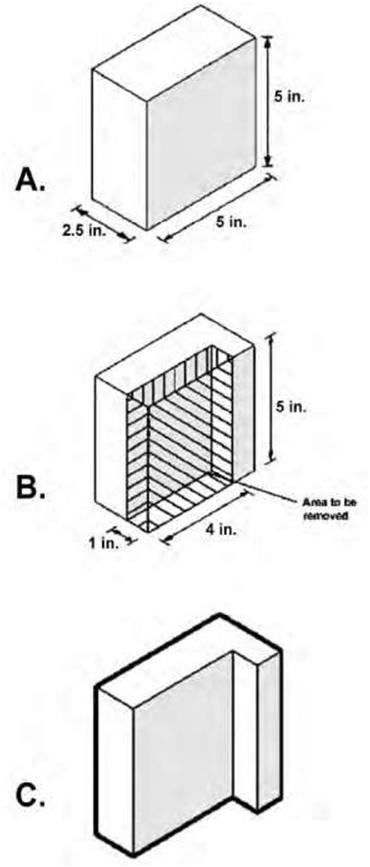 | |||
| Figure v.twenty Steps to depict a circle in isometric projection. | |||
| 98 | Chapter five | ||
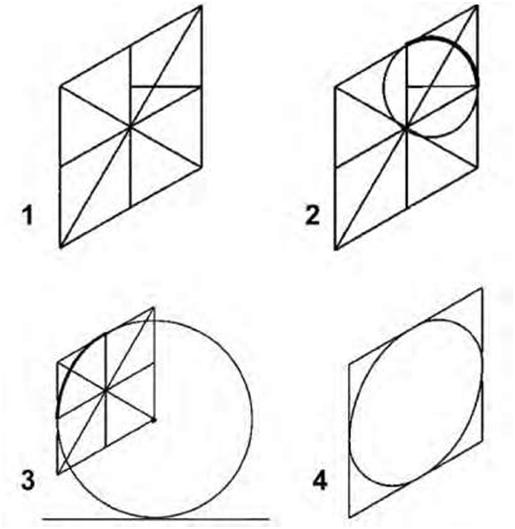 | |||
| Figure 5.21 Steps to draw a circle in isometric project. | |||
 | |||
| Figure 5.22 A comparing of isometric, dimetric and trimetric drawings (source: Wikipedia). | |||
| Types of Views | 99 | ||
| spectively, take unlike ratios of foreshortening (and are therefore drawn at different scales) when projected to the plane of projection. The wide angle choice gives the designer considerable flexibility and control of the pictorial view. In trimetric projections, the direction of viewing is such that all of the three axes of space appear unequally foreshortened. The scale along each of the iii axes and the angles amidst them are adamant separately as dictated by the bending of viewing. Approximations in trimetric drawings are common. Limitations of Axonometric Projection Objects drawn with axonometric project practice non appear larger or smaller as they extend closer to or further away from the viewer. While advantageous for architectural drawings and sprite-based video games, this results in a perceived distortion, as, unlike perspective project, it is not how our eyes or photography usually piece of work. An additional problem in the case of isometric project is that at that place are times when it becomes difficult to determine which face of the object is existence observed. In the absence of proper shading, and with objects that are relatively perpendicular and similarly proportioned, it can go difficult to determine which is the top, bottom, or side of the object, since each face is given similar dimensions. | |||
| 5.7 PICTORIAL DRAWINGS | |||
| Pictorial drawings are not often used for construction purposes. However, on some working drawings pictorial views are used to reveal data that orthographic views alone would be incapable of showing; other situations may require a pictorial drawing essentially to supplement a major view. Pictorial projection, unlike multiview projection, is designed to allow the viewer to see all 3 primary dimensions of the object in the projection. Pictorial architectural drawings and renderings are very piece of cake to empathise and are therefore used extensively to draw a three-dimensional view of an object and for explaining project designs to laypersons for sales-presentation purposes. They enable an inexperienced person to interpret drawings and quickly visualize the shape of individual parts or diverse components in complicated mechanisms. To convey as much information as possible, the view is oriented to testify the sides with the most features. In many cases, orthographic (multiview) drawings provide information in a format that makes it difficult for laypersons to visualize the total project. Orthographic/multiview drawings are typically dimensioned and are usually drawn to a specific scale (Figure v.23). Although pictorial drawings may be dimensioned and fatigued to calibration, their main purpose is to give a three-dimensional representation of the building or object. As illustrators ofttimes take artistic liberties with scale and proportion, the reader should just utilise pictorial drawings for general reference. And although they are not usually dimensioned and verbal scaling is not required, proportions are nevertheless expected to be maintained. When pictorial drawings are dimensioned and contain other specifications that are needed to produce the part or construct the object, they are considered to be working drawings. Whereas a multiview drawing is designed to focus on only two of the three dimensions of the object, a pictorial drawing provides an overall view. The tradeoff is that a multiview drawing generally allows a less distorted view of the features in the two dimensions displayed while lacking a holistic view of the object (thus needing multiple views to fully describe the object). | |||
| 100 | Affiliate 5 | ||
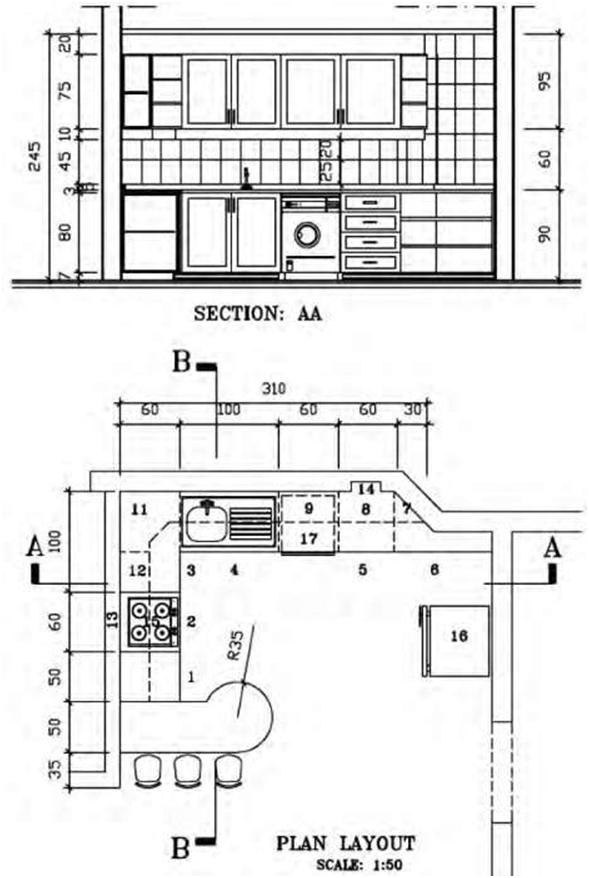 | |||
| Effigy 5.23 Drawing showing an orthographic view (programme and section) of a kitchen design. | |||
| Types of Views | 101 | ||
| The aforementioned dimensioning rules that use for an orthographic/multiview drawing also apply to a pictorial drawing. These include: Dimension and extension lines should be drawn parallel to the pictorial planes. When possible, dimensions are placed on visible features. Arrowheads prevarication in the same aeroplane equally extension and dimension lines. Notes and dimensions should exist lettered parallel to the horizontal plane. The three master types of pictorial drawings that are extensively used in architectural presentations are perspective drawings, isometric drawings, and oblique drawings. The main difference between isometric and typical perspective drawings is that in the latter the lines recede to vanishing points. This gives the cartoon a more realistic appearance but is technically inaccurate. Isometric drawings, on the other hand, prove true dimensions. Even so, they create an optical illusion of baloney, mainly because the human heart is accepted to seeing long object lines recede. For this reason, isometric drawings are primarily utilized for clarification of small construction details, since they depict their true size dimensions. In an oblique drawing ii or more surfaces are shown at one time on one drawing. The front face of an object is drawn in the same way as the front view of an orthographic sketch. 5.viii PERSPECTIVE DRAWINGS | |||
| A good understanding of the principles of perspective is necessary to create an accurate and visually appealing slice of art. Perspective drawings are forms of pictorial drawing. Blueprint readers may not meet a perspective cartoon very often, only they volition undoubtedly capeesh the descriptive information it offers. Perspective drawing is a arrangement for representing three-dimensional space on a flat surface. It utilizes either one, two, or three points to where the receding lines volition vanish. These vanishing points are placed along a horizontal line chosen a horizon line. In perspective drawings receding lines are no longer parallel to each other as in oblique or isometric drawings. In perspective drawings, afar objects appear smaller only have the same shape and proportions as they would close up. In other words, as objects are further abroad, they become smaller and appear to vanish into the distance. The general principle behind perspective drawing is uncomplicated and shares many features with the fashion people actually perceive space and objects in information technology. It depends essentially on iv interconnected criteria that will invariably affect the final image: the level of our eyes when viewing the scene or object, thus determining the horizon line; the distance from the moving-picture show plane to the object; the distance from the station indicate to the object and cone of vision; and the angle of the object to the flick aeroplane. Perspective drawings may be drawn equally impressive artistic renderings to show landscapes or large structures. They tin can also be used to show a realistic representation of machine parts or layouts of architectural furnishings in a room. Perspective drawings are more difficult and time-consuming and are not used as extensively equally they might be. They are used mainly for illustrative purposes, but their use as a descriptive drawing in manufacturing environments should non be overlooked. In essence, in that location are iii bones types of perspective drawings that are unremarkably used in architectural pattern and structure: one-betoken perspective, two-point perspective, and three-bespeak perspective. | |||
| 102 | Affiliate 5 | ||
| 1-Point (Parallel) Perspective The constabulary of perspective is that parallel lines that lie in the same aeroplane will appear to converge to a single point somewhere on the horizon (at the middle level), called the vanishing point (VP). This point is usually positioned inside the view and gives objects an impression of depth. To depict a one-point perspective, but draw a horizon line (HL) and draw a vanishing point anywhere on it. The horizon line may be located above, beneath, or at any other location on the drawing. Vertical and horizontal lines are fatigued ordinarily, and all receding lines are drawn to the vanishing point. Thus, the sides of an object diminish towards the vanishing betoken, whereas all vertical and horizontal lines are fatigued with no perspective—i.e., face on (Figure 5.24). A normal-view angle places the HL at a natural summit as if the viewer were looking straight ahead without tilting the caput up or down. Effigy 5.25 shows 2 examples of normal-view one-point perspective. Altering the position of the VP changes the view of the object beingness drawn. For example, to look downwardly at the height of the object, the vanishing point must be above the horizon line while to look up at the object, it must be below the horizon line. It is advisable to practice identifying the best locations for vanishing points to attain the desired results. One-point perspective depicts a edifice or interior space with one side parallel to the picture airplane (perpendicular to the observer'south line of sight). To set up a one-point perspective, connect the corners of the elevation to the vanishing betoken and marking off the depth through the lines of sight in the plan (Figure v.26). I-point perspectives are oft used to depict interiors, every bit they requite an accurate depiction of the facing wall, in add-on to both receding side walls. They are besides typically used for roads, railroad tracks, interiors, and buildings viewed so that the front is directly facing the viewer. Objects that are fabricated up of lines either direct parallel or perpendicular to the viewer's line of sight can exist drawn with one-point perspective. Still, it is of limited use, mainly because the perspective is too pronounced for modest products, making them appear larger than they actually are. Ii-Point Perspective Sometimes chosen angular perspective drawing; in this method only the vertical lines are drawn vertically. The horizontal, depth, and length receding lines are drawn to the vanishing points located on the horizon line. The front view is no longer truthful in shape but is now drawn in an isometric configuration. Again, the location of the horizon line and the vanishing points on the line will provide many different "looks" of the object. In two-signal perspective the sides of the object vanish to one of ii vanishing points on the horizon. Vertical lines in the object have no perspective applied. Our distance from an object seen at an angle determines where the vanishing points lie on the horizon. 2-point perspective is a much more useful drawing system than the simpler one-betoken perspective and the more complex iii-point perspective. Objects drawn in two-point perspective have a more natural look. Effigy v.27 illustrates a typical architectural application of two-point perspective for a department-store interior. To prepare a ii-point perspective, connect the corner height line to the correct and left vanishing points, and, with the lines of sight in the plan, mark off the depth of the object. The procedure for constructing a two-indicate perspective view is essentially the same every bit for 1-point perspective except for the additional pace of establishing ii vanishing points. In ii-signal perspective y'all can make the object look big or small by altering the proximity of the vanishing points to the object (Figure v.28). Shade and shadow are often used in perspective drawings to give a better perception of the depth and form of a infinite or object. The drawing of shadows and reflections both follow the same immutable rules of perspective. | |||
| Types of Views | 103 | ||
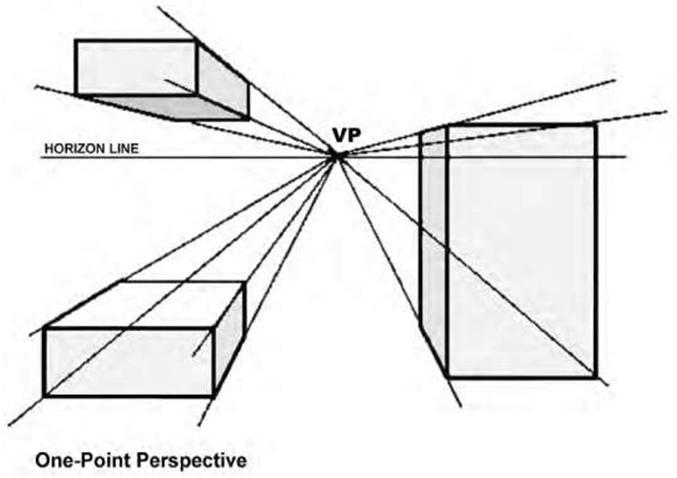 | |||
| Figure 5.24 A elementary i-point perspective. Although it is possible to sketch products in one-point perspective, the perspective is often too aggressive to the eye, making objects appear bigger than they actually | |||
| are. | |||
| The illustration in Figure 5.29 demonstrates how to draw a box in two-indicate perspective: 1. Put two vanishing points at opposite ends of the horizontal line. 2. Draw the front vertical of the box. Drawing the line beneath the horizontal will create a view that we are looking down on. To look at the object from beneath, depict the front vertical above the horizontal. three. Draw lines from the acme of the vertical that disappear to both of the vanishing points. Echo the process for the lesser of the line. 4. To complete both sides, draw in the back verticals. 5. To draw the height of the box, describe lines from the back verticals to the opposite vanishing points. | |||
| 104 | Chapter 5 | ||
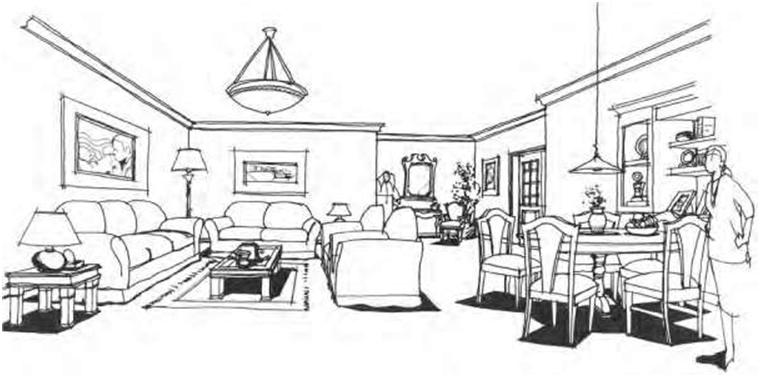 | |||
| Figure 5.25A A. Illustration of an interior using normal-view 1-point perspective. | |||
| Three-Point Perspective Three-bespeak perspective is a development of two-indicate perspective and is usually used for buildings seen from in a higher place or beneath. Like two-point perspective information technology has 2 vanishing points somewhere on the horizon and a third somewhere above or below the horizon line toward which the verticals converge (Effigy five.30). This ways that the object is either tilted to the picture airplane or the spectator's key axis of vision is inclined upwards or downwardly and the picture aeroplane is tilted. Three-indicate perspectives usually indicate that the spectator is very close to the object or that the object is very large. It is all-time used for drawing alpine objects such as buildings, although this form of perspective is not widely used in architectural presentations. Its all-time use may be to evidence a particular viewpoint of a tall object such as a skyscraper. This type of drawing is sometimes called an oblique perspective cartoon, every bit the vertical lines are drawn to the tertiary vanishing bespeak not located on the horizon line. 4-, five-, and six-bespeak perspective drawings are more than complex and challenging and require considerable understanding and skill to execute. In general, nearly designers create drawings with a vanishing point far beneath the horizon so that the depth added to the verticals is only slight. In many cases the vanishing betoken isn't even on the newspaper. Learning how to apply vertical perspective will brand your drawings more and more than realistic. | |||
| Types of Views | 105 | ||
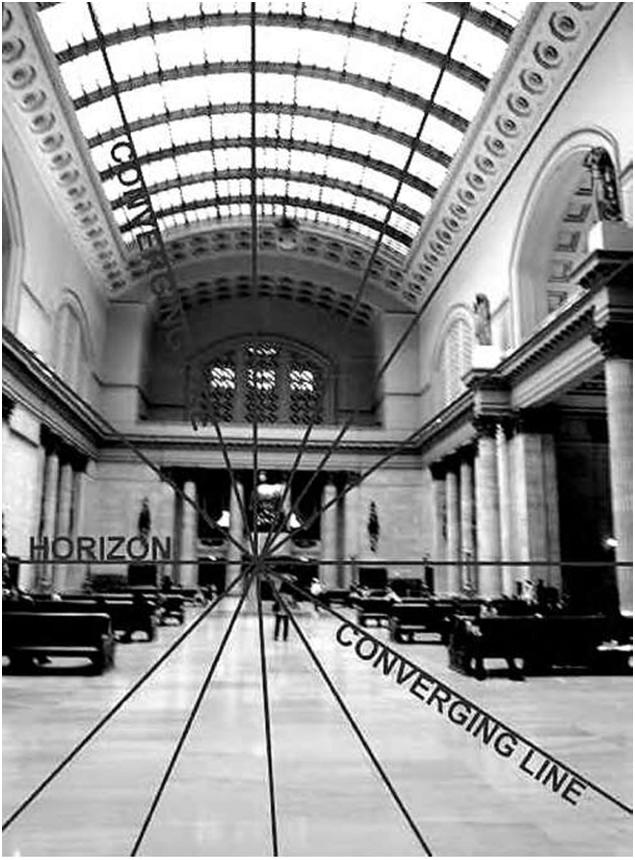 | |||
| Figure 5.25B A photograph of an interior infinite depicting a normal-view 1-point perspective and showing the converging lines and horizon (source: Randy Sarafan). | |||
| 106 | Chapter 5 | ||
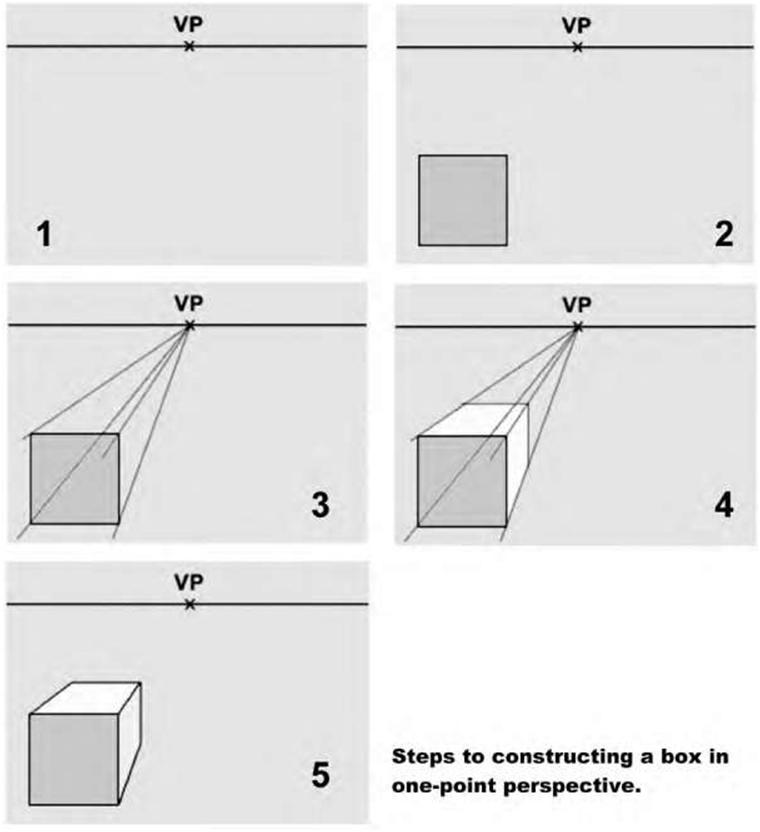 | |||
| Effigy 5.26 To construct a box in one-point perspective, draw a horizon line (HL) and place a vanishing point (VP) somewhere on this line; draw a foursquare somewhere beneath the horizon—this volition be the forepart of your box; draw 4 lines, i from each corner of the square that must pass through the vanishing point; and lastly, draw in the back vertical and horizontal to consummate the box. | |||
| Types of Views | 107 | ||
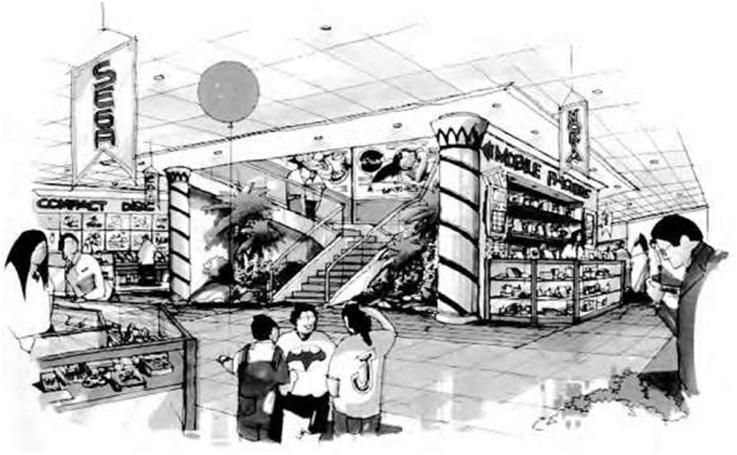 | |||
| Figure five.27 A typical architectural awarding of a two-bespeak perspective used to show a department store interior. | |||
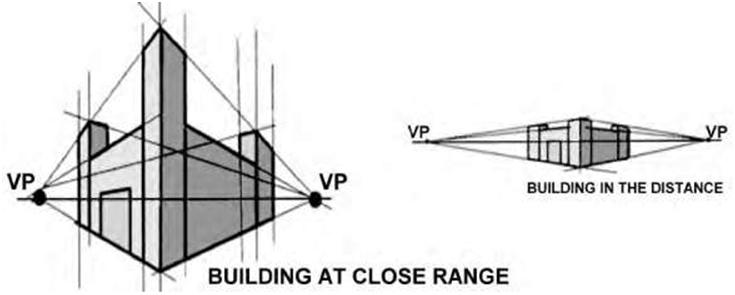 | |||
| Figure 5.28 In ii-indicate perspective you can brand the object expect large or small by altering the proximity of the vanishing points. In the image on the left the vanishing points are shut to the edifice; the epitome on the correct shows the vanishing points far abroad from the building. | |||
| 108 | Chapter 5 | ||
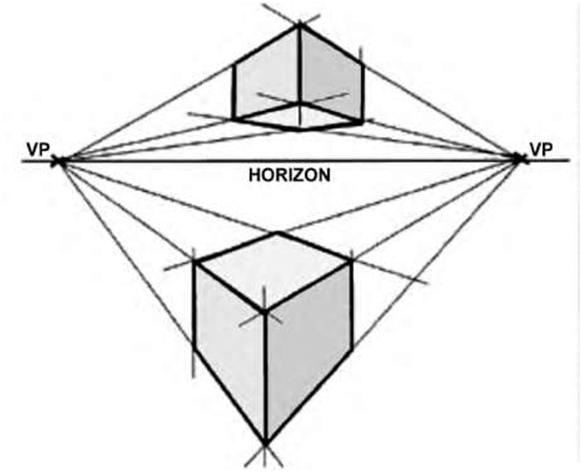 | |||
| Figure 5.29 A simple 2-point perspective of objects drawn above and below the horizon line. | |||
| Types of Views | 109 | ||
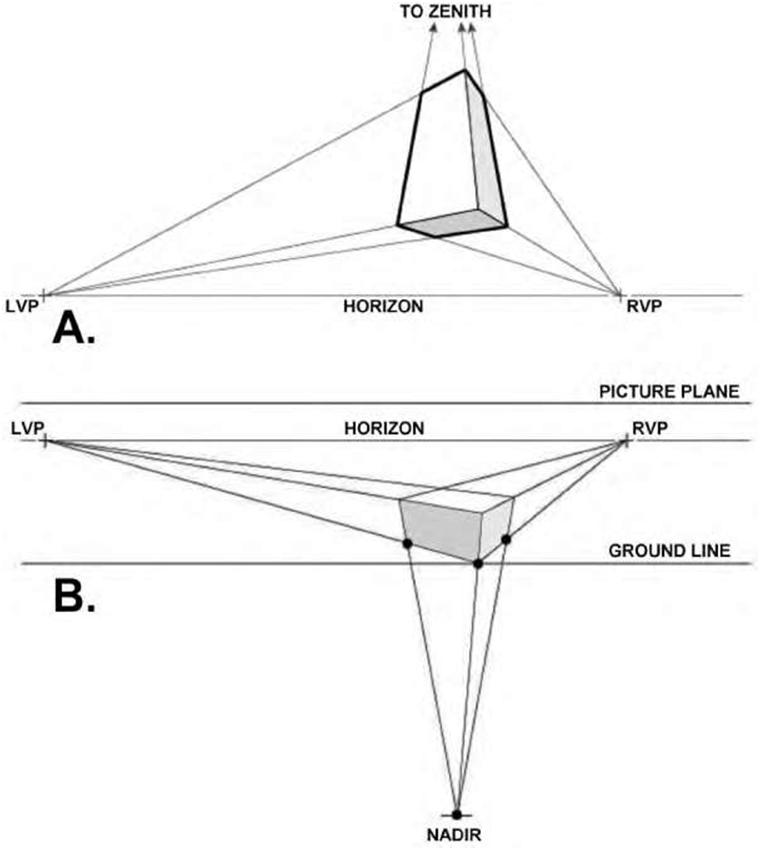 | |||
| Figure 5.30A,B Two examples of a three-betoken perspective, one with the vanishing point above the horizon and the other with it below (source: Kevin Hulsey). | |||
Source: https://www.construction53.com/2011/08/blueprint-types-of-views/
0 Response to "What Are the Different Drawing Views of the Body Called"
Post a Comment